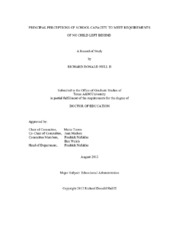| dc.description.abstract | The purpose of this study was to determine if significant differences existed in principals’ perceptions of their school’s capacity to meet Adequate Yearly Progress (AYP) requirements between principals whose schools failed to meet AYP requirements for one year compared to principals whose schools failed to meet AYP requirements for two to four consecutive years. Additionally, responses of the principals were analyzed based on the level of school, the location of the school, and if the school was or was not a Title I campus.
A total of 2,040 schools met the criteria of the study and a finite population sampling method was utilized where the entire population of eligible principals was invited to participate in the study. A quantitative online survey was distributed to principals of eligible schools. A total of 183 principals responded, for a participation rate of nearly 10%.
The study utilized two statistical methods for analyzing discrete data. Independent-t tests were conducted to determine if there were statistically significant differences in principals’ perceptions of their school’s capacity between principals of schools that failed to meet AYP requirements for one year, and those that failed to meet AYP requirements for two to four consecutive years. It was found that there were not statistically significant differences in principals’ perceptions of their school’s capacity.
The second method of analyzing data was to conduct two-way ANOVAs to test for statistically significant differences in perceptions of principals based on level of school, type of school, and Title I status. It was found that there were not any statistically significant differences in principals’ perceptions of their school’s capacity.
The absence of statistically significant differences in principals’ perceptions of their school’s capacity to meet AYP requirements regardless of the number of years the school missed the requirements, location of the school, type of school, or Title I status of the school could reasonably lead to the conclusion that capacity domains of schools fail to predict success of schools. This however, would contradict most literature that has previously been written about school capacity. Other more reasonable conclusions, as well as future research are presented in this study. | en |


